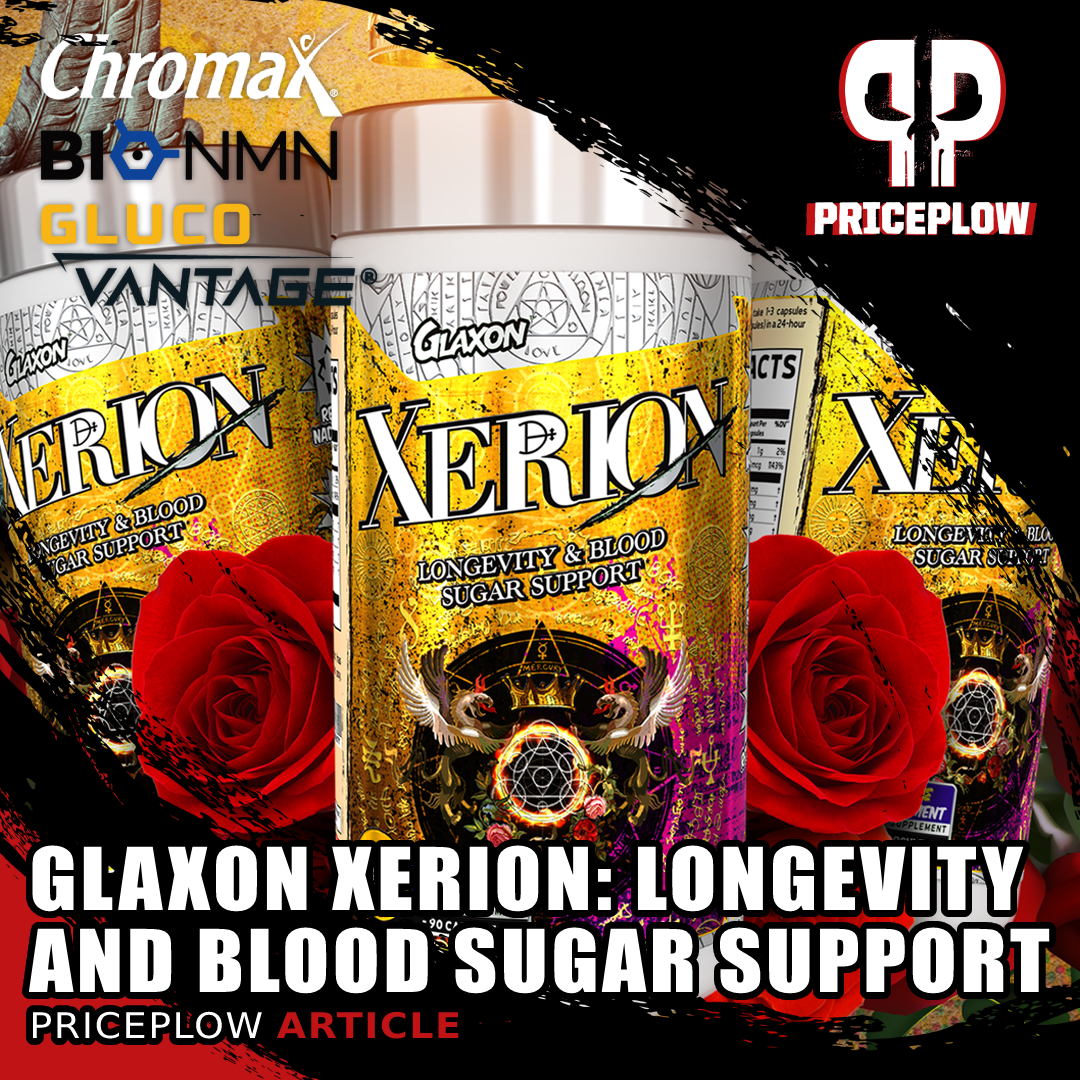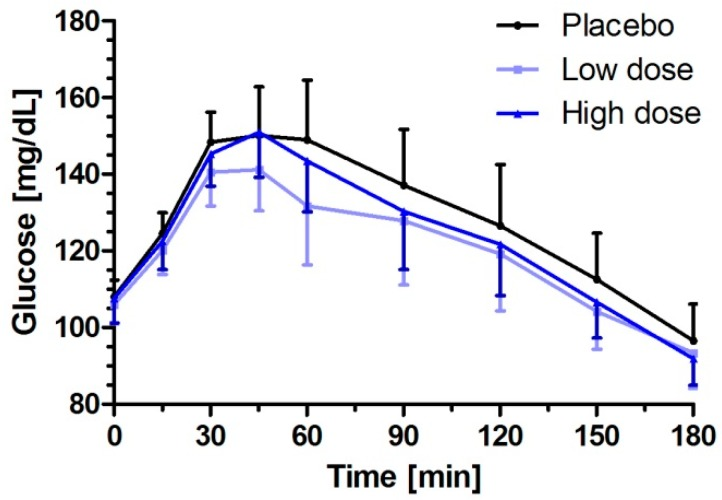
Glaxon is a brand that doesn't put out weak supplements. We've been waiting for a GDA (Glucose Disposal Agent) from them, and it's here in a big way.
By now, most of us who are into health and fitness understand how important it is to keep glucose under control. If you routinely subject your body to huge blood glucose spikes, you will eventually damage your tissues through hyperglycemia.[1] Your pancreas will have to work overtime to bring those high blood sugar levels down, and if it goes on long enough, you might become insulin resistant, permanently reduce or even destroy the ability of your pancreas to secrete insulin. Such a situation can ultimately lead to Type 2 Diabetes (T2D), a lifelong blood sugar issue that requires pharmaceutical or dietary intervention.

Using both tried-and-true and novel ingredients, Glaxon Xerion is an incredibly unique play for longevity-boosting insulin-sensitivity. Enjoy your carbs with this one!
A major key to promoting longevity and greater overall health is keeping your blood sugar and insulin levels under control while you're still metabolically healthy. Prioritizing this should not only make you generally healthier, but can also help you achieve and maintain a lean body composition, since insulin resistance leads to weight gain and other symptoms of the "metabolic syndrome".[2] And unfortunately, even if you do everything right, you'll see some loss of insulin sensitivity and blood sugar control as you age.[3,4]
On top of avoiding overconsumption of foods that lead to this state (refined carbohydrates and processed seed oils high in omega-6 fatty acids), we can do more to promote longevity and metabolic health:
Glaxon Xerion: A powerful blood sugar supplement with a longevity boost
Chromax fronts the label to bring us an efficacious dose of chromium (as chromium picolinate). And that's just the beginning...
Enter Xerion, the promising new blood sugar control supplement from our friends over at Glaxon. Xerion is formulated to head numerous metabolic issues off at the pass, keeping both blood glucose and insulin under control. It uses a handful of truly awesome ingredients ranging all the way from Nutrition21's insulin-sensitizing mainstay Chromax chromium picolinate to a superior form of berberine in the form of GlucoVantage dihydroberberine to the new kid on the block, a cutting-edge protein-based peptide named Pep2Dia.
It will stack incredibly well with Glaxon Thermal, a stimulant-free weight loss drink mix, and can be used both for diet applications and for bulking applications in those who want to make the most of their carbohydrates.
You know the drill – let's look at these superstars and break down their efficacy one by one, but first, check out our coupon-based prices and sign up for our Glaxon news alerts, since there's a lot more coming:
Glaxon Xerion – Deals and Price Drop Alerts
Get Price Alerts
No spam, no scams.
Disclosure: PricePlow relies on pricing from stores with which we have a business relationship. We work hard to keep pricing current, but you may find a better offer.
Posts are sponsored in part by the retailers and/or brands listed on this page.
Glaxon Xerion Ingredients
-
Chromium (Chromium (III) Picolinate as Chromax) - 400 mcg (1143% DV)
With two legendary ingredients in Chromax and GlucoVantage alongside two first-timer ingredients in Pep2Dia and BioNMN, Xerion will be a new and powerful experience.
Anyone who's been in the supplement world for a few years has definitely heard of chromium before, and if you're interested in chromium, there's no better-researched form of it than Nutrition21's Chromax Chromium Picolinate.
Chromium heavily interacts with insulin,[5-7] and chromium picolinate has been repeatedly shown to blood improve glucose levels and insulin sensitivity, especially in insulin-resistant individuals.[8,9] When compared to other forms of chromium, chromium picolinate gets the most pronounced results.[9]
With these effects, it should be unsurprising that people taking chromium supplements are at a significantly lower risk of having type 2 diabetes,[10] while those with chromium deficiency are at significantly greater risks for all kinds of metabolic disorders.[11] Chromium has also been shown to help remove fat from tissues where it doesn't belong,[12] such as in the liver with non-alcoholic fatty liver disease (NAFLD), which is a hallmark of the metabolic syndrome.
Body composition improvements at this dose
There are body composition improvements as well, especially at the dose Glaxon is using in Xerion. Studies have shown that both 200 micrograms and 400 micrograms of chromium picolinate (the dose we have here in three daily capsules) can help significantly improve human body composition when compared to placebo.[13,14]
Chromax is a trademarked formulation of chromium picolinate made by Nutrition21, and is the most extensively studied form of chromium. Mechanistically, it has been shown to significantly decrease blood glucose and upregulate the activity of the GLUT4 glucose transporters in rats.[15] That's a big deal, because GLUT4 is the glucose transporter that responds to insulin, and is responsible for removing glucose from the bloodstream after a meal. It's no surprise, then, that in a randomized controlled trial of type 2 diabetes patients, subjects taking chromium picolinate showed a significant improvement in HOMA-IR,[16] a measure of whole-body insulin resistance.
Chromax is also significantly more bioavailable than competing forms of chromium, and with an absorption rate over twice that of the next most readily absorbed type of chromium.[17]
For over 25 years, Chromax chromium picolinate has been improving insulin sensitivity. We argue that it's only gotten better, as dietary deficiencies have gotten worse over this time period.
Overall, Glaxon started things off right by not allowing you to neglect your essential chromium, using industry-leading Chromax. You can read more in our articles titled Chromax Chromium Picolinate: 25+ Years of Insulin Sensitivity Improvement and Chromium Picolinate: The Ultimate Trace Mineral For Insulin Sensitivity, or keep going, because the new ingredient in Xerion is up next:
-
Milk Protein Hydrolysate (as Pep2Dia) - 1400 mg
Milk and whey protein is famous (or infamous) for its ability to stimulate the secretion of insulin,[18] so you might be surprised to see it in a supplement that's supposed to control insulin levels. However, Glaxon isn't just using whey protein here: Pep2Dia is a patented alanine-proline (AP) peptide that's derived from whey protein hydrolysate.[19]
Pep2Dia exploit's whey protein's ability to inhibit an enzyme called alpha-glucosidase, which breaks down glucose and makes it available to the body, thus raising blood glucose levels.[20] Certain anti-diabetic drugs work in this same manner (by inhibiting alpha-glucosidase),[21] but with Pep2Dia, we have a milk-derived, supplemental form here that's extracted for the protein peptide combination with similar effects.[22-24]
This was the response after just a single use![25,26] Sensitivity improves with repeated use over time as well.
A team of researchers who studied Pep2Dia found that at a dose of 1400 mg, by "counteracting alpha-glucosidase action," the Pep2Dia protein "delays... carbohydrate hydrolysis and consequently extends its digestion time (gastric emptying), which results in reduced glucose absorption from the gastrointestinal tract".[25,26] Overall, the researchers found that compared to controls, the postprandial rise in blood glucose was significantly reduced in people taking Pep2Dia.[25,26]
When it comes to insulin, the story is a bit more complicated. The scientists observed a reduction in blood insulin levels both postprandially, and "a slight improvement of whole-body insulin sensitivity" in people who took 1400 mg Pep2Dia for six weeks.[25,26] However, these reductions were not statistically significant, so a larger study would be needed to confirm if they are real.
At the very least, you can rest assured that supplementing with this peptide won't be raising your insulin levels while you benefit from its very real effects on gastric emptying and carbohydrate metabolism. You can read the Pep2Dia patent for more detailed information.[19]
Note: with Pep2Dia, you'll get 1 gram of protein in the entire daily serving of three capsules.
-
Dihydroberberine (as GlucoVantage) - 300 mg
GlucoVantage, a superior form of berberine developed and patented by NNB Nutrition, is a clever bit of engineering. The ingredient is scientifically known as dihydroberberine, and is a metabolite of berberine, but with better properties:
There's no better GDA ingredient than berberine, and there's no better form of berberine than dihydroberberine in NNB's GlucoVantage!
When a person ingests berberine, it has to be converted to dihydroberberine by that person's gut flora before it can be absorbed into the intestinal wall, where it is converted back to berberine and released into the bloodstream.[27] It then goes on to improve insulin sensitivity and glucose disposal by boosting the body's release of AMPK (AMP-activated protein kinase), which we consider to be our "energy metabolism enzyme".[28,29] This process helps drive glucose into the muscle cells as opposed to fat,[30] while promoting insulin sensitivity through adiponectin release from the fat tissue.[31]
This leads to numerous benefits, including:
- Better glucose uptake[32,33] (especially into muscle tissue)[29,34]
- Improved insulin sensitivity and generally better insulin levels[35]
- Body composition improvements (more muscle while dropping fat)[32,35]
- Better overall metabolic and lipid markers[31,32]
The problem with regular berberine, and how GlucoVantage solves it
However, berberine has a problem: awful bioavailability.[36-38] The rate at which this occurs varies from person to person, and in some people, it happens so slowly that most of the berberine they ingest doesn't end up getting used at all before it's eliminated, making the berberine supplement a pointless waste of money for them. It also requires higher doses, and the excess berberine can irritate the gut, causing nausea, flatulence, or other similar symptoms.
NNB Nutrition's scientists realized that if you synthesized dihydroberberine and administered it to people directly, you could side-step this rate-limiting process, creating a berberine supplement that is much more reliable and effective. And that's exactly what they did in creating and patenting GlucoVantage.[39,40]
By taking dihydroberberine rather than berberine, you get far greater bioavailability and longer lasting effects -- as much as 5x stronger![41,42]
This means there's a lower dose required, and with 300 milligrams in a total day's dosage of Xerion, we have what we consider to be the biological equivalent of a clinical 1500 milligram dosage of regular berberine -- only without all the nasty side effects!
You can read far more in the following three articles:
-
Beta-Nicotinamide Mononucleotide (as BioNMN) - 250 mg

NNB Nutrition's BioNMN takes NMN bioavailability to a new level, and is backed by an incredibly innovative novel ingredient development team
BioNMN is another high-bioavailability ingredient from NNB Nutrition, consisting of nicotinamide mononucleotide (NMN), a derivative of vitamin B3. NMN is one of the precursor molecules to NAD+,[43] a molecule that drives the electron transport chain that is so fundamental to the working of every cell in the body.[44]
Without NAD+, our bodies can't move energy from the food we eat into our cells, where it can do useful work. Obviously, this is a very basic metabolic process, so it's not surprising that age-related declines in the body's levels of NAD+[43,45] lead to neurodegeneration, vascular damage, and fatty liver, metabolic disease, and many other conditions.[46] That makes NMN, and other substances that can increase NAD+ production, crucial elements of any cutting-edge anti-aging strategy.
Why is it in the Glaxon Xerion? Because recent research has demonstrated that NMN supplementation can improve muscle insulin sensitivity in women.[47] This study is covered in great detail in our article titled "New NMN Study: Improved Muscle Insulin Sensitivity in Women".
See how NMN improves insulin sensitivity in overweight / insulin resistant women, and it's dramatic for a few individuals.[47]
Further, NAD+ repletion, unsurprisingly, has been shown to improve insulin sensitivity and glucose control. It probably does this by activating the SIRT1 gene, which is protective against the metabolic syndrome.[48]
Additional research has shown that administering NMN to mice will directly raise their NAD+ levels, and stave off age-related physiological declines.[49,50]. Further human research demonstrated that there is solid evidence that NMN is both well-tolerated in human subjects, and also raises blood levels of 2Py and 4Py, the final metabolites in the metabolic cycle involving NAD+.[51] Although the researchers in this study did not measure NAD+ levels directly, the presence of these "final metabolites" strongly implies that NAD+ levels were raised by the NMN.[51]
Need more clean energy? Then there's a good chance you need more NAD+ -- and an incredible way to generate more is with NMN Supplementation.
We're incredibly excited about BioNMN and how it can help alongside GlucoVantage in blending the longevity and insulin sensitivity strategies. We originally thought NMN would be best for stimulant-free energy applications (and it still is), but with direct evidence that it improves muscle insulin sensitivity, it's a perfect fit for Glaxon Xerion.
You can read far more about it in our articles titled "NMN Supplements (Nicotinamide Mononucleotide): The NAD+ Energy Precursor" and "BioNMN: A Reliable NMN Supplement Ingredient".
-
Black Pepper (Piper nigrum) [Fruit] Extract [Std. to 95% Piperine as BioPerine] - 5 mg
The piperine in black pepper extract is famous for its ability to facilitate the absorption of other nutrients, but it also has an independent beneficial effect on blood sugar.
In terms of metabolic-specific improvements, piperine improves the function of the same crucial glucose transporter that chromium does, namely GLUT4, the one that responds to insulin and clears glucose from the blood after a meal.[52] Black pepper extract has also been shown to help reverse insulin resistance and fatty liver in mice.[53]

This Glaxon Xerion label is no joke! You can also see an image of the back of the Xerion label
Xerion Dosage
The above dosages are the entire day's worth of three capsules, but they don't have to be taken all at once. You can take 1 capsule prior to each major meal (up to three capsules per day), or all three capsules before your most carbohydrate-laden meal.
The product will work best when taken before carbs. Anecdotally, we've had success with these supplements on low-carb, high-protein diets, but would likely stick to one or two capsules per day total if not using many carbohydrates. Again, use them before the biggest meal (in the case of low-carb, stack it before a high protein, gluconeogenic meal).
Stacking: Many options
Xerion can be stacked with numerous Glaxon supplements, ranging from the stimulant-free Thermal weight loss powder or even the ultra-intense Specimen G.F.Y pre workout supplement (which actually doubles as a high-stim fat burner if you look at the profile).
Xerion Brings the Insulin Sensitivity House
In true Glaxon style, Xerion brings us some legendary ingredients alongside some new, cutting-edge ingredients. We love to talk about highly-tested compounds like chromium and berberine, and you know Glaxon's going with the good stuff in Chromax and GlucoVantage. The dosages are worth highlighting again - Chromax is dosed where you have successful body composition research, while GlucoVantage is dosed to the point of a day's equivalent of 1500 milligrams of berberine, yet without the wasted space and side effect profile.

Chromax is the industry's most trusted and tested form of chromium picolinate, helping users stay insulin sensitive for decades
Meanwhile, we're extremely excited to see the first supplement using BioNMN, which we're confident will have more research demonstrating insulin sensitivity and mitochondrial health benefits. Pep2Dia is also novel, and you can expect to see more milk-driven peptides find their way into dietary supplements, as they can be extracted to bring incredible benefits without the calories or space taken.
With many other diet-related supplements already out, you could say that a quality glucose disposal agent supplement was overdue from Glaxon. Long story short, they did not disappoint.
Glaxon Xerion – Deals and Price Drop Alerts
Get Price Alerts
No spam, no scams.
Disclosure: PricePlow relies on pricing from stores with which we have a business relationship. We work hard to keep pricing current, but you may find a better offer.
Posts are sponsored in part by the retailers and/or brands listed on this page.










Comments and Discussion (Powered by the PricePlow Forum)